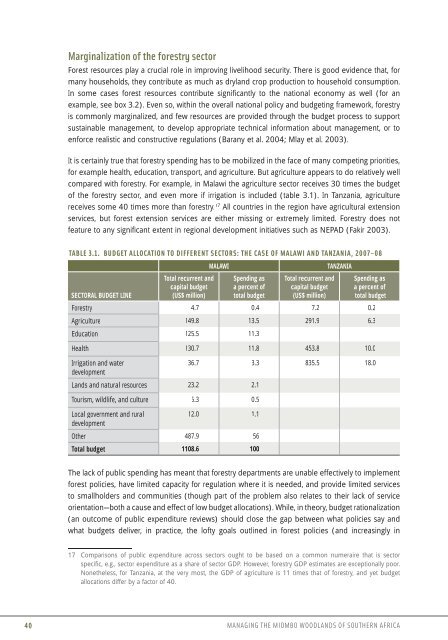Managing the Miombo Woodlands of Southern Africa - PROFOR
Managing the Miombo Woodlands of Southern Africa - PROFOR
Managing the Miombo Woodlands of Southern Africa - PROFOR
Create successful ePaper yourself
Turn your PDF publications into a flip-book with our unique Google optimized e-Paper software.
Marginalization <strong>of</strong> <strong>the</strong> forestry sector<br />
Forest resources play a crucial role in improving livelihood security. There is good evidence that, for<br />
many households, <strong>the</strong>y contribute as much as dryland crop production to household consumption.<br />
In some cases forest resources contribute signifi cantly to <strong>the</strong> national economy as well (for an<br />
example, see box 3.2). Even so, within <strong>the</strong> overall national policy and budgeting framework, forestry<br />
is commonly marginalized, and few resources are provided through <strong>the</strong> budget process to support<br />
sustainable management, to develop appropriate technical information about management, or to<br />
enforce realistic and constructive regulations (Barany et al. 2004; Mlay et al. 2003).<br />
It is certainly true that forestry spending has to be mobilized in <strong>the</strong> face <strong>of</strong> many competing priorities,<br />
for example health, education, transport, and agriculture. But agriculture appears to do relatively well<br />
compared with forestry. For example, in Malawi <strong>the</strong> agriculture sector receives 30 times <strong>the</strong> budget<br />
<strong>of</strong> <strong>the</strong> forestry sector, and even more if irrigation is included (table 3.1). In Tanzania, agriculture<br />
receives some 40 times more than forestry. 17 All countries in <strong>the</strong> region have agricultural extension<br />
services, but forest extension services are ei<strong>the</strong>r missing or extremely limited. Forestry does not<br />
feature to any signifi cant extent in regional development initiatives such as NEPAD (Fakir 2003).<br />
TABLE 3.1. BUDGET ALLOCATION TO DIFFERENT SECTORS: THE CASE OF MALAWI AND TANZANIA, 2007–08<br />
MALAWI<br />
TANZANIA<br />
SECTORAL BUDGET LINE<br />
Total recurrent and<br />
capital budget<br />
(US$ million)<br />
Spending as<br />
a percent <strong>of</strong><br />
total budget<br />
Total recurrent and<br />
capital budget<br />
(US$ million)<br />
Spending as<br />
a percent <strong>of</strong><br />
total budget<br />
Forestry 4.7 0.4 7.2 0.2<br />
Agriculture 149.8 13.5 291.9 6.3<br />
Education 125.5 11.3<br />
Health 130.7 11.8 453.8 10.0<br />
Irrigation and water<br />
36.7 3.3 835.5 18.0<br />
development<br />
Lands and natural resources 23.2 2.1<br />
Tourism, wildlife, and culture 5.3 0.5<br />
Local government and rural<br />
12.0 1.1<br />
development<br />
O<strong>the</strong>r 487.9 56<br />
Total budget 1108.6 100<br />
The lack <strong>of</strong> public spending has meant that forestry departments are unable effectively to implement<br />
forest policies, have limited capacity for regulation where it is needed, and provide limited services<br />
to smallholders and communities (though part <strong>of</strong> <strong>the</strong> problem also relates to <strong>the</strong>ir lack <strong>of</strong> service<br />
orientation—both a cause and effect <strong>of</strong> low budget allocations). While, in <strong>the</strong>ory, budget rationalization<br />
(an outcome <strong>of</strong> public expenditure reviews) should close <strong>the</strong> gap between what policies say and<br />
what budgets deliver, in practice, <strong>the</strong> l<strong>of</strong>ty goals outlined in forest policies (and increasingly in<br />
17 Comparisons <strong>of</strong> public expenditure across sectors ought to be based on a common numeraire that is sector<br />
specifi c, e.g., sector expenditure as a share <strong>of</strong> sector GDP. However, forestry GDP estimates are exceptionally poor.<br />
None<strong>the</strong>less, for Tanzania, at <strong>the</strong> very most, <strong>the</strong> GDP <strong>of</strong> agriculture is 11 times that <strong>of</strong> forestry, and yet budget<br />
allocations differ by a factor <strong>of</strong> 40.<br />
40 MANAGING THE MIOMBO WOODLANDS OF SOUTHERN AFRICA

















